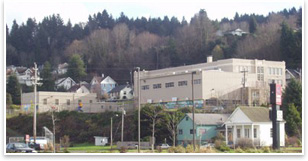
Best Practices
For years, Astoria, Ore., a port at the mouth of the Columbia River, compared itself unfavorably to Seaside, a charming oceanfront resort nearby. Astoria residents felt ashamed of their blue-collar history of fish-processing plants, shipping, and port activities and wished to become a tourist destination like Seaside. Susceptible to planners who preyed on the community’s poor self-image, city leaders approved a plan to bulldoze much of the downtown and port and replace them with a highway, parking, and oversized resort projects.
Some years later, Astoria leaders had second thoughts and, with the help of the Oregon Downtown Development Association, reversed their course. Their alternative reinvestment strategy embraced the working port as both primary industry and attraction for visitors. Public investment is stabilizing and, in some cases, expanding ports businesses. Abandoned port buildings are being repaired for a wide variety of new uses, and pedestrian improvements (including sidewalks, flowers, and street furnishings) encourage people to walk from downtown to the waterfront.
Tourists and local sightseers enjoy the port activity from “people places”—specially designed viewing aediculae, which are small, raised, partly enclosed towers. Located not to interfere with the working waterfront, they are close enough so that visitors feel that they are a part of the fish-processing, cargo-loading, and tug-boating activities that usually are hidden from everyone but the laborers. Within walking distance through the waterfront is a one-of-a-kind maritime museum that reinforces the ambiance of the working port. By reversing its ill-placed status seeking, Astoria is revitalizing its economy through an appropriate strategy that is grounded in its traditional, if modest, identity. Its new prestige is a model of place-appropriate economic development. Copyright 2006 Massachusetts Institute of Technology. Reprinted with permission. |
||
Copyright 2006 The American Institute of Architects. All rights reserved. Home Page |
||
home
news headlines
practice
business
design
recent related
› SDATs Help Two Massachusetts Cities Envision Sustainable Futures
› Beautiful, Green, and Affordable
› Integrated Design/Integrated Development Conference Selects Four Winning Green Projects
Randolph T. Hester is professor and former department chair with the University of California, Berkeley, Department of Landscape Architecture and Environmental Planning. He is a principal with Community Development by Design.
For more information about Design for Ecological Democracy, visit the AIA Web site.
Captions:
Image 1: The Columbia River Maritime Museum is the terminus for Astoria riverboat tours. Photos courtesy of the Astoria Riverfront Trolley Association.
Image 2: Astoria’s working-town character attracts movie makers. Kindergarten Cop was set in Astor School.
Image 3 : Instead of a new highway, Astoria Riverfront Walk will extend along this old trolley track.
Image 4: A former net loft will become artist studios and small shops.

 Summary:
Summary: Many communities suffer from inferiority complexes. They compensate by being something they are not. Misguided status seekers lose their collective identity and increase wasteful public consumption of scarce resources but never achieve the prestige they desire.
Many communities suffer from inferiority complexes. They compensate by being something they are not. Misguided status seekers lose their collective identity and increase wasteful public consumption of scarce resources but never achieve the prestige they desire. Waterfront businesses, the town’s considerable history, and fine historic buildings were scheduled to be razed, and a placeless resort—not at all like charming Seaside, without any relationship to Astoria, and undistinguished from hundreds of other chain hotel complexes all over the world—was scheduled to be built. Worse, the waterfront would be severed from downtown and accessible only by car, creating segregated tourist enclaves.
Waterfront businesses, the town’s considerable history, and fine historic buildings were scheduled to be razed, and a placeless resort—not at all like charming Seaside, without any relationship to Astoria, and undistinguished from hundreds of other chain hotel complexes all over the world—was scheduled to be built. Worse, the waterfront would be severed from downtown and accessible only by car, creating segregated tourist enclaves. In stark contrast to the highway proposal, this action has helped reconnect the port and Main Street businesses and has stimulated economic activity in both. Local people have rediscovered the special pleasures of their won town. Visitors come not for staged tourist experiences but rather for t he working waterfront that was once a source of local embarrassment. Yes. The fish processing is of major interest to tourists. It is real work and authentic entertainment; it allows the city to be what it is.
In stark contrast to the highway proposal, this action has helped reconnect the port and Main Street businesses and has stimulated economic activity in both. Local people have rediscovered the special pleasures of their won town. Visitors come not for staged tourist experiences but rather for t he working waterfront that was once a source of local embarrassment. Yes. The fish processing is of major interest to tourists. It is real work and authentic entertainment; it allows the city to be what it is.